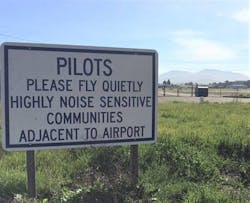Let’s Speak Openly About Aviation and Environmental Justice
The U.S. has a long history of implementing pivotal regulations to protect the environment and advance sustainability. This benchmark legislation has paved the way for federal agencies to consider environmental justice in their activities and work with the community toward collaborative solutions.
First enacted in 1963 and amended many times since, the Clean Air Act is the comprehensive federal law regulating air emissions from stationary and mobile sources. Among other things, this law authorizes the Environmental Protection Agency (EPA) to establish national air quality standards to protect public health and regulate emissions of hazardous air pollutants.
In 1970, the National Environmental Policy Act (NEPA) established a broad national framework for protecting the environment and assessing the environmental effects of federal agencies’ proposed actions. Via a subsequent presidential executive order over two decades later, the government issued instructions for federal agencies to make environmental justice part of their mission. This made them responsible for identifying and addressing disproportionately high and adverse human health or environmental effects on minority and low-income populations.
In response to a growing aircraft noise problem, Congress passed the Airport Noise and Capacity Act (ANCA) in 1990. ANCA is significant because it shifted responsibility for noise abatement away from local governments and airport sponsors, and granted the Federal Aviation Administration (FAA) preemptive authority over the setting of noise levels and imposition of noise and capacity restrictions at airports.
Today, supporting environmental sustainability is a primary focus of the Biden administration for airports and the aviation industry. For instance, the 2022 Inflation Reduction Act provided funding for historic investments in environmental justice to improve public health, reduce pollution and revitalize low-income communities that are overburdened by pollution.
How do these regulations impact the aviation industry and the national airspace system, now and into the future?
The current administration has an aggressive agenda to reduce greenhouse gas emissions, utilize renewable forms of energy and aim to achieve net-zero emissions by 2050. For the aviation industry, this means a new focus on technology to utilize green energy and reduce carbon emissions.
In support of this environmental agenda, the industry and a growing number of general aviation businesses are actively participating in initiatives related to sustainable aviation fuels, solar power and battery storage systems, alternative unleaded aviation gasoline, eliminating per-and polyfluoroalkyl substances (PFAS), and aircraft noise mitigation technologies.
Advancements are also being made in fixed-base operator (FBO) and aviation facility infrastructure efficiencies, such as LEED-certified construction, new building efficiency code requirements, and storm water retention and infiltration.
Most notably, leaders of aviation and petroleum groups have committed to a plan for transitioning piston-engine aircraft to lead-free aviation fuels by the end of 2030. This Eliminate Aviation Gasoline Lead Emissions (EAGLE) initiative calls for an industry and government partnership to expand and accelerate the actions and policies necessary for this change to happen.
In a related action last October, the EPA issued a final determination that emissions from aircraft operating on leaded fuel cause or contribute to air pollution, which could be expected to endanger public health and welfare under the Clean Air Act.
As a result, general aviation airports and FBOs are under increased pressure from political and community stakeholders to ban the sale of low-lead aviation fuel before a viable and safe alternative is available. However, aviation industry experts agree this transition must be accomplished without compromising the existing U.S. transportation infrastructure system, aviation safety, and the economic and broader public benefits of general aviation.
This presents a challenge of conflicting agendas that must be managed or resolved for sustainable transformation to take place. In light of the critical safety and other issues at stake, the EPA finding is only one key step in the overall process. And, this fact must be managed as such by the FAA.
It remains the responsibility of the FAA to ensure the successful development and deployment of a viable unleaded aviation gasoline alternative through deliberate rulemaking. This process includes the creation of a new fuel standard, which has not been previously accomplished. The FAA approves the use or fuels in aircraft engines, not the fuel itself. Any less effort could threaten the national air transportation system, as well as access to the approximately 5,200 public use airports serving general aviation aircraft.
The same conclusion can be drawn in regard to the introduction of measures to reduce noise and emissions associated with aircraft operations. Currently, some lawmakers are proposing measures to allow for local regulation over aircraft noise. Such actions pose the threat of limiting access to airports, weakening the economic base of communities and undermining ANCA. Specifically, they risk negatively impacting interstate commerce provisions and protections to states.
Perhaps one contributing factor is that new residents who have not previously lived near an airport are moving into neighborhoods impacted by aircraft noise. These newcomers are often unaware of advances in technology that have made aircraft quieter or of an airport’s proven voluntary and mandatory noise management programs.
As a growing number of airport stakeholders push the environmental justice agenda forward, often beyond reasonable or feasible limits for national benefit, the missing piece is how to ensure that our nation’s airports continue to provide a critical lifeline to the communities they serve.
General aviation aircraft fulfill an essential role in pilot training, as well as fire management, humanitarian aid, air ambulance and other life-saving missions. According to the National Air Transportation Association (NATA), general aviation businesses support 1.2 million jobs and provide over $247 billion in economic output.
Without our nation’s general aviation airports, many cities would face a serious void in public safety and disaster relief capabilities, as well as opportunities to support high-skilled jobs, economic activity and connectedness in diverse communities. Regulating airports has just as much to do with social justice as environmental justice.
Despite these facts, some members of Congress are working to provide their constituents relief from airport noise by revisiting policy contained in ANCA. Last June, a bipartisan committee of the Senate jointly proposed legislation to amend a section of the Federal Aviation Act.
This proposed legislation calls for: 1) the evaluation of existing research on aircraft noise impacts and annoyance; 2) the assessment of alternative noise metrics that could be used to supplement or replace the existing Day Night Level (DNL) standard; 3) the evaluation of the current 65-decibel exposure threshold including the impact to land use compatibility around airports if such threshold were lowered; and 4) the evaluation of current noise mitigation strategies and the community engagement efforts by the FAA.
This is less than positive news for the aviation industry, as it opens the door to revising the current regulatory framework for noise mitigation. Members of the general aviation industry must work collectively to combat shortsighted policy proposals with facts about how they threaten to weaken the national airspace system and the communities served by airports.
In addition, this requires the leadership and voice of the national aviation trade associations, as well as airport sponsors, tenants, users and operators. It also involves setting realistic expectations of what may and may not be accomplished at the local level.
It is time to tell the public and elected leaders what they need to hear, not what they want to hear. Only then can members of the general aviation industry work in partnership with members of the local community to advance both social and environmental justice.
About the Author

Curt Castagna
President and CEO
Curt Castagna, President/CEO of Ascension Group Partners, serves as president and CEO of the National Air Transportation Association, member and past chair of the Los Angeles County Airport Commission, and president of the Van Nuys and Long Beach airport associations. A certified private, seaplane and instrument-rated pilot, he continues to instruct courses in aviation administration at Cypress Community College and Cal State Los Angeles.
